In Spain, a gene that causes hereditary sudden death is identified
Thursday, October 30, 2014
A mutation of a gene is responsible for the development of hereditary sudden death and cardiac abnormalities. This emerges from a study, conducted by researchers from Oviedo and Asturias, who have sequenced the genome of Spanish patients with hypertrophic cardiomyopathy.
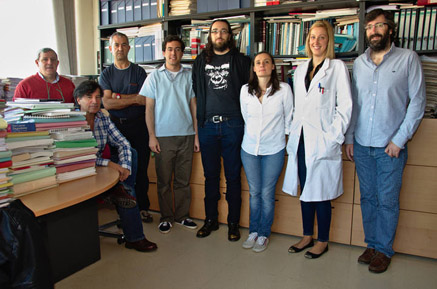
Researchers of the University of Oviedo
The Hypertrophic cardiomyopathy is a relatively common disease, that is a leading cause of sudden death, in young adults, reports the University of Oviedo.
In recent years, the study of familial cases of this disease has revealed several genes, whose mutations cause their development, in approximately 50% of patients; however, are completely unaware of the genes, causing hypertrophic cardiomyopathy, in the remaining patients with this pathology.
The study, published in the journal Nature Communications, has identified a new inherited form of this disease and find the mutated gene, responsible for its development.
This research team has used the new techniques of genomic analysis, developed in the laboratory of Biochemistry and Molecular Biology, in the University of Oviedo, as a part of the deciphering of the genomes of cancer.
Researchers have concluded, that "mutations in the CNLF gene, encoding a protein called filamin C, cause hypertrophic cardiomyopathy, in eight of the families studied", said Dr. S. Xosé Puente.

Figure representing a cardiac molecule with mutant Filamin C
After discovering these mutations, the research team analyzed the mechanisms underlying the development of the disease, which has demonstrated, say the first authors signers of the article, Rafael Gutierrez and Ana Valdes-Fernandez: "The mutations, in CNLF, cause the formation CNLF aggregates of these proteins, in the cardiac muscle, that are accumulated over time and prevent the proper functioning of the heart".
This discovery has important and immediate clinical applications, because according to the doctors Eliezer Coto and Jose Julian R. Reguero, "it will allow for genetic counseling, in families, and identify mutation carriers in CNLF, which are subject to ongoing clinical monitoring". "If necessary, they implant a defibrillator, that avoids the process that triggers sudden death in these patients", they concluded.
The work was led by Dr. Carlos Lopez-Otin and Dr. S. Xose Puente, from the Institute of Oncology, in the University of Oviedo, and has enjoyed the participation of groups of doctors Eliezer Coto, Jose Julian R. Guerrero and Aurora Astudillo, from the Central University Hospital of Asturias.
The work, in the institutions participating in this project, is funded by the Ministry of Economy and Finance, the Carlos III Institute of Health, the Social Work Cajastur, the Botin Foundation and the Asturcor Foundation.
Well, I think this news is so interesting and I hope that all of these researchers can strengthen this project, to help millions of people, not only in Spain but throughout the world.
Until my next post, kind regards,
Luis.
Sponsored by Costaluz lawyers.
Please click below:

 0
Like
Published at 1:12 PM Comments (0)
0
Like
Published at 1:12 PM Comments (0)
In a Spanish University, a molecule that reduces body fat is found
Wednesday, October 29, 2014
Blueberries, blackberries and red wine are some of the foods and drinks, in which thepterostilbene, a phenolic compound (a phenol is an aromatic ring, attached to at least one functional group. Many are classified as secondary metabolites of plants, those products biosynthesized, in plants, that possess the biological characteristic of being by-products of their metabolism), that is present in small amounts, has reduced body fat accumulation and may decrease the risk of have other diseases like diabetes, in animal testing.
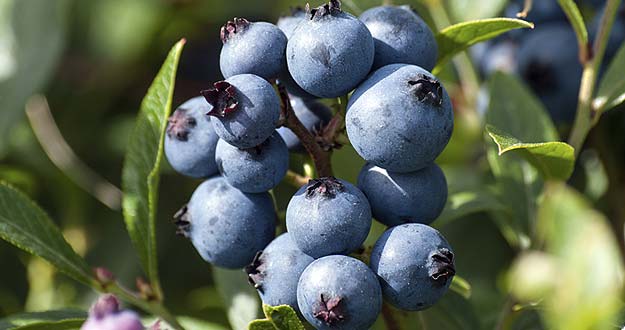
Blueberries

Blackberries

Red wine
So it has been demonstrated by an investigation of the University of the Basque Country (UPV) and the Carlos III Institute of Health, in collaboration with the Department of Agriculture of the United States of America (USDA) and it has been published in the “Journal of the Agricultural and Food Chemistry”.
In the pre-clinical study, conducted, the pterostilbene reduced body fat, due to a reduction in fat synthesis, in adipose tissue, and increased oxidation in the liver.
Obesity is a chronic disease, that is defined as an excessive accumulation of body fat and it is caused by many factors, as reported by the UPV, in a note.
This is a highly prevalent metabolic disease, in developed countries, and an important risk factor, for developing certain diseases and disorders, such as insulin resistance, diabetes, fatty liver, alterations in plasma lipids and hypertension, among others.
Traditional guidelines, for the prevention and treatment of obesity, include tracking a low calorie diet and practice of moderate physical activity, over time.
However, the effectiveness of these strategies is limited and success is not always achieved the desired. In this context, to include some functional ingredients, in the diet, opens new prospects for treatment.
As examples of these ingredients, are phenolic compounds, including pterostilbene, that is also present in grapes and peanuts, among other foods.
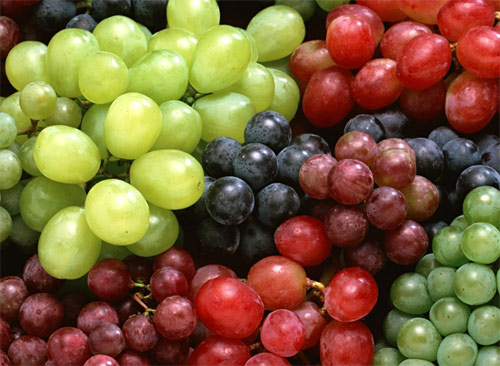
Grapes
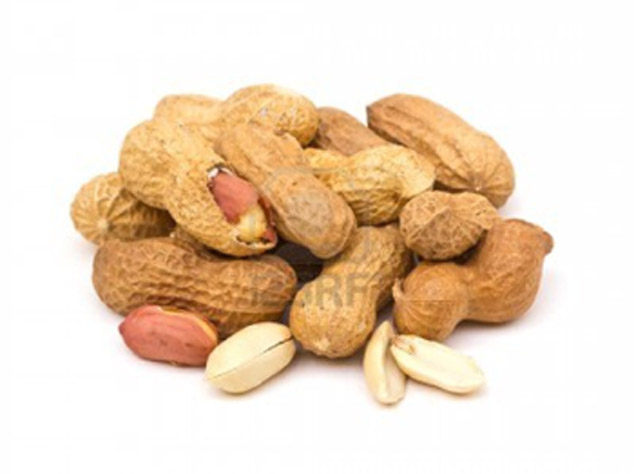
Peanuts
At present, there are few studies analyzing the effects of this molecule, and are primarily focused on cancer.
The study, in this research, is the first pre-clinical work, that analyzes the effects of this phenolic compound, on obesity, in an animal model.
These promising results, which have led to a patent, may be the starting point for the implementation of future intervention studies, in humans, to confirm this effect for anti-obesity.
I hope that is so, that researchers can apply this method to human patients.
Until my next post, kind regards,
Luis.
Sponsored by Costaluz Lawyers.
Please click below:

 0
Like
Published at 11:53 AM Comments (0)
0
Like
Published at 11:53 AM Comments (0)
Spanish researchers discovered significant amounts of arsenic in food for celiac
Tuesday, October 28, 2014
Researchers at the Miguel Hernández University of Elche (UMH), (Alicante, Eastern Spain) have analyzed the presence of arsenic in flour, bread, sweets, pasta, beer and milk, made with rice, for people with celiac disease.
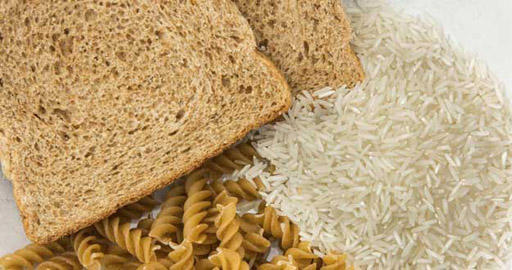
Bread, pasta and rice
Not only people with Celiac disease, almost 1% of the Western population cannot tolerate gluten and are forced to consume products without that substance, such as rice.
However this cereal, depending on its origin,may also contain “worrisome” levels of arsenic.
Arsenic is a toxic and carcinogenic element according to research from SYNC. (Statewide public agency, specialized in information about science, technology and innovation, in Spanish).
The results of the analysis, presented in the journal Food Additives & Contaminants, warn that some of these products contain "important content" of total arsenic (As-t, up to 120 mg / kg) and inorganic arsenic (As-i, up to 85.8 mg / kg).
The total arsenic is the sum of organic, which is combined with carbon, and the inorganic, that react with other elements such as oxygen, chlorine or sulfur, and it is more harmful.
These data were estimated contents of As-t and As-I, just used rice, as the main ingredient, --rejecting other components of food-- and have proven to be as high as 235 and 198 mg / kg, respectively.
In addition, the daily intake of inorganic arsenic, taked by celiac, when they consume products with rice, is estimated at 0.46 and 0.45 mg / kg (micrograms per kilogram of body weight), for women, and men aged 58 and 75 kg, respectively.
And, in the case of children (up to five years), these values are even higher, ranging between 0.61 and 0.78 mg / kg, according to another study, published in the Journal of Food Science.
An expert panel of the European Food Safety Authority (EFSA) of the EU, established, in 2009, that there are evidences that the intake range between 0.3 and 8.0 mg / kg of body weight, per day, is a risk of cancer lung, skin and bladder. The estimated intakes, in the two studies, is moved therefore within that range.
"These values indicate that we can not exclude a health risk to people, who consume these products", says Ángel Carbonell, co-author of the studies, although he recognizes an important point: "The EU has not yet established legal limits of the levels of arsenic, in rice and foods made of this cereal; but, now, it is actively working on it”.
The advice of researchers is clear: "A legislation, by health agencies to delineate arsenic levels which must not exceed the rice-based foods for celiac consumers, is needed".
To date, celiac disease was diagnosed mainly in children; but, in recent years, the profile has changed and "one in five people", with the disease, is older than 65 years.
At present, every European country is taking samples of these products, analyzing and submitting the results to the EFSA, to develop a database large enough to make decisions.
The Spanish Agency for Consumer, Food Safety and Nutrition (AECOSAN) submitted their report for which the researchers of this study can collaborate.
Another of their key recommendations is to include a quality information on labels: "It should indicate the content of inorganic arsenic, that takes each item, just like identify either the rice variety used and its origin, because some are more desirable than others", stresses Sandra Munera, another author.
Arsenic occurs naturally in the earth crust; but, in some regions, its abundance is higher than in others, and its concentration also increases with the use of pesticides. Then this element is diffused through the water to rice, one of the few plants that are grown flooded.
One of the most "purest" rice in the world is from the National Park of Doñana (Almonte, Huelva, South western Spain). This mainly because it has not been exposed to the use of pesticides and arsenic is not abundant naturally in this location.
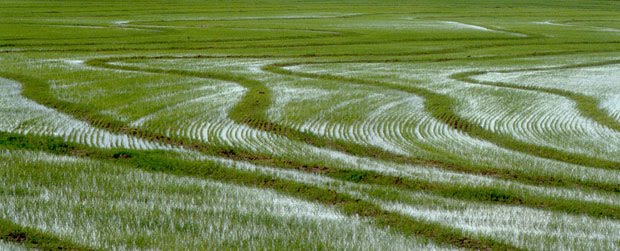
Rice field in the Natural Park of Doñana
However, in countries like India and Bangladesh, where the waters are contaminated with inorganic arsenic and rice is a staple food for the population, this could be the result of one of the largest mass poisoning in history.
Well, I hope that E.U. can assist in this area and help deal with this serious problem.
Until my next post, kind regards,
Luis.
Sponsored by Costaluz Lawyers.
Please click below:

 0
Like
Published at 5:40 PM Comments (0)
0
Like
Published at 5:40 PM Comments (0)
Pipirrana: A typical dish in the South of Spain
Monday, October 27, 2014
The “Pipirrana” or "Piriñaca" is consumed in the provinces of Granada, Jaen, Almeria, Murcia and south of Ciudad Real, a very long time ago. It is the accompaniment used in the city of Cadiz, for grilled fish, especially mackerel. Each province has a different preparation and composition.
In Jaén, this salad is made with peeled tomatoes, emulsifying much oil, tuna, green pepper and garlic. And it is eaten getting wet soups (ie to soak pieces of bread). In another version it is very common throughout the province, because the simplicity of its preparation makes it ideal to eat anywhere, especially in summer. It is also very common in rural environments, since such simplicity makes it ideal for eating in the field.
In the area of the Sierra de Cazorla-Segura-Las Villas, the "pipirrana rin-ran" is preparated a variant in which all ingredients are mash, resulting in a kind of very thick mashed potato. This variant usually takes cumin, very often in the kitchen area.
In the province of Cadiz there is a dish called “mackerel with Piriñaca”. The fish is roasted in special racks and the Piriñaca, composed by chunks of onion, tomato, pepper, seasoned with olive oil, vinegar and salt, is added.
In Cieza (Murcia) “pimpirrana” or “pipirrana” is prepared with a lot of onion (cut into small pieces and macerated whole day in water), dried cod and chips pepper variety “ñora” (lightly grilled), olive oil, apple cider vinegar, salt and sometimes black olives. Occasionally, is added, according to taste, some spice like cumin, savory, rosemary or another.
In Murcia, it is elaborated on the basis of romaine lettuce, cucumber, pepper variety ñora, black olives, garlic, dried cod or sardines boot, tomato, oil, salt and lemon.
It is also commonly consumed in the southern province of Ciudad Real, in Valdepeñas, where it is cooked with tomatoes (often shredded), olives, boiled egg, tuna, chopped onion, salt and a drizzle of olive oil. In Bolaños de Calatrava, where it is made with mackerel, tomato, olives, lettuce and onion, and served chilled.
In Cuenca (its part of La Mancha), specifically in Horcajo de Santiago, a different pipirrana is done, because unlike other, this is a casserole. A typical and exquisite dish, because of the variety of foods that it admits: birds, good quality sausages, salted cod, pork, mushrooms, seasoned with bay leaf, garlic, black pepper, onion, dried tomato, hot pepper and potatoes.
Well, I am going to talk you about recipe similar than the recipe from the southern province of Ciudad Real. The diference is that my recipe has no tuna and either mackerel.
These are the ingredients for 4 servings: 1 medium onion. 3 branch tomatoes, not very mature. 1 green pepper. 1 red pepper. 1 cucumber. 1 clove garlic. 2 eggs. Olive oil. Sherry vinegar. Salt.
Time for cooking: 15 minutes.
To begin, wash all vegetables. The onion peel and chop small; the peppers open, we dry the white part and the seeds of them and chop the same size as the onion; we have to peel cucumber and cut it in half, then get to the part of the seed, which is what makes repeat; peel the garlic, remove the green germ them inside, cut them in half and chop it such finer as we can. In a separate saucepan, put the eggs covered in water, with a drop of vinegar and salt and put it to cook for eleven minutes, before cooling in cold water. A rather cold, peel and chop one as the same size of the vegetables, the other one reserve for garnish.
In a large bowl, we prepare a vinaigrette, with three parts of oil to one of vinegar; we put salt, to taste, and whisk until emulsified. Add vegetables and egg, to the bowl, and let cool for about an hour.
To show it, we do the following: In four dinner plates, spread the mixture of pipirrana and add, above, a few slices of boiled egg; put sauce, with the vinaigrette, to everything, thoroughly.
And, this must be the result:
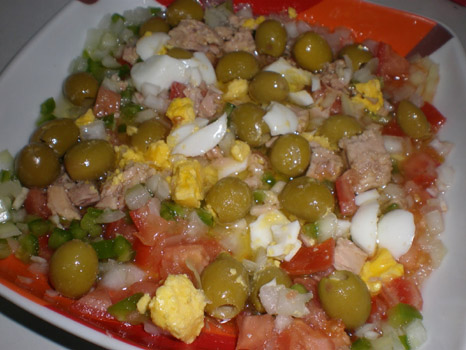
"Pipirrana"
Well, I hope that you want to try to cook this recipe, if you did not know it.
Until my next post, kind regards,
Luis.
Sponsored by Costaluz Lawyers.
Please click below:

 0
Like
Published at 7:30 PM Comments (0)
0
Like
Published at 7:30 PM Comments (0)
A Royal visit to an Exemplary Village in Spain
Friday, October 24, 2014
This afternoon, the delivery of the “Princes of Asturias Awards” 2014 will be held, in Oviedo (Asturias, North western Spain). This year, it is the first time that Mr. Felipe and Mrs. Letizia will attend as Kings of Spain; but also it will be the last time, because, from next year, the Princess Leonor shall be who shall give the name “Princess of Asturias Awards”.
But today I do not want to talk about the delivery of the “Princes of Asturias Awards” --which are certainly very important, since Mr. Felipe established them, in 1981, under the name of "Prince of Asturias Awards"--. I want to talk about the visit, that Their Majesties the Kings Felipe VI and Mrs. Letizia will make the Boal Council.
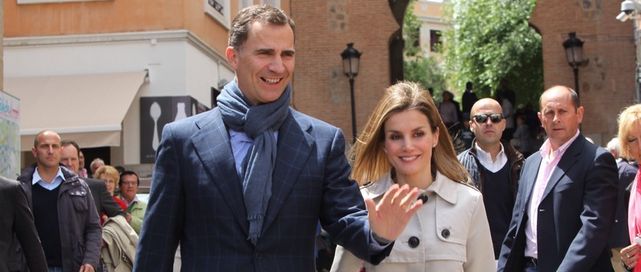
Their Mejesties The Kings Felipe VI and Mrs. Letizia
Boal is a small town (1,700 inhabitants); but very nice, and, therefore, among other reasons, it has just received the distinction of "Exemplary Town of Asturias", an Award which will be given, to the Mayor, by Their Majesties the Kings.
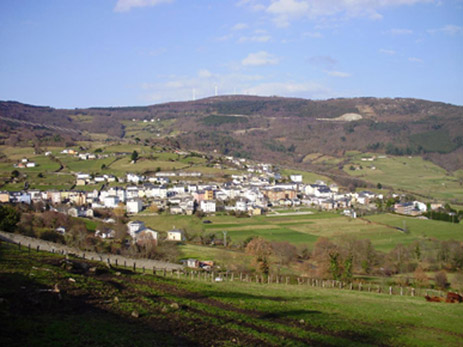
Boal, Asturias
This Award recognizes the organizational capacity of its citizens, to carry out numerous activities, that have allowed the council give vitality and promote their economic, social, cultural, athletic and educational development.
Tomorrow, The Kings will walk through the streets of the town, to see the houses of Indians, in the lower part of this territory.
Also, the Kings will visit the washroom, the Asturias Avenue, a monument dedicated to emigration, the City Hall, the home of beekeeping and graduate schools.
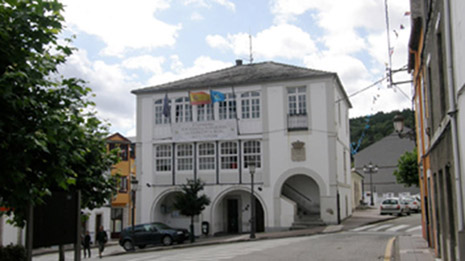
The City Hall of Boal
Their visit to Boal will end at noon, after enjoying a lunch. The kings can enjoy lifelines broth, roast beef with potatoes, cheese with honey from the village and “venera” (typical dessert from the Navia Basin).
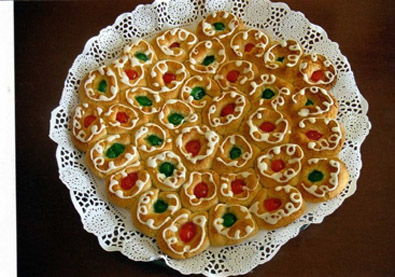
Venera
It is said that honey from Boal is very very good.
Well, I hope that you can watch on tv the Delivery of the Princes of Asturias Awards, this afternoon.
I am glad with the visit of the new Kings to Boal, because I think that they are going to be very good Kings for Spain.
Until my next post, kind regards,
Luis.
Sponsored by Costaluz Lawyers.
Please click below:

 0
Like
Published at 3:02 PM Comments (0)
0
Like
Published at 3:02 PM Comments (0)
The solution against allergy to lactose, discovered in Spain
Thursday, October 23, 2014
Scientists, at the University of Granada (UGR) and the “Azti-Tecnalia” technological centre, have developed a milk protein, more easily digested, by the human body, and which could reduce the allergenicity of milk, maintaining their properties.
The researchers have managed to change, by treatment with pulsed light, a milk protein called “Beta-lactoglobulin”.
This protein, present in whey, is responsible for approximately 10% of dairy allergies and thanks to this treatment is much more digestible.
As explained by the UGR researcher, Julia Maldonado-Valderrama, one of the authors of this work, published in the journal “Soft Matter”, the difficult digestion of Beta-lactoglobulin is because these proteins have a compact and complex structure, that resist enzymatic attack, during digestion.
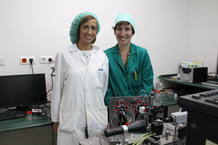
Teresa del Castillo Santaella and Julia Maldonado-Valderrama
"However, this structural complexity is necessary for proteins, to perform its structural function as a stabilizer of emulsions or foams agent", explained.
One way to facilitate the digestion of proteins, could be breaking or unwinding its structure. However, if the structure of the protein is too degraded, it loses its functionality.
"We used a milk protein modified, by pulsed light treatment, a method of bacterial inactivation widely used in the food industry; but it had never been applied before, to modify proteins", said Maldonado-Valderrama.
This process, patented by the equipment of the “AZTI-Tecnalia” technological centre, degrades the protein structure, as the number of light pulses applied is increased.
Thus, in this work, first of all, the scientists found, that the functionality of the protein is not affected by the pulsed light treatment.
"In fact, we show that the pulsed light, in some cases, even improves the emulsifying properties of milk protein. After, we check the effect of digestion on this modified protein, with pulses of light", says the researcher.
To do this, the researchers used a device, designed and built at the University of Granada, called Octopus, which allows them to simulate the digestive process of a protein, in a single drop of emulsion.
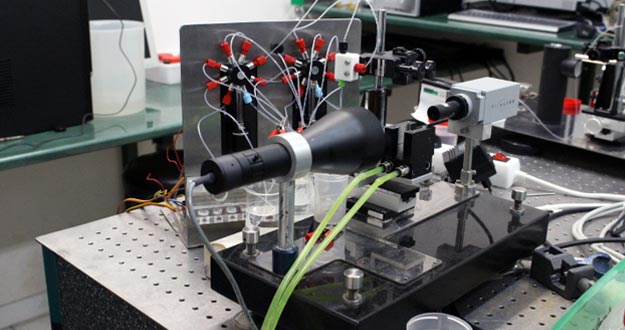
"Octopus"
Thus, the simulation of the digestive process showed that light treatment facilitates the digestion of the protein, particularly in the small intestine.
"Finding ways to improve the digestibility of proteins, without altering its functionality, is an ongoing challenge, in food technology, and, in this sense, the pulsed light treatment is a promising tool to design food products of low allergenicity", concludes the researcher from the UGR.
Well. I think this project is so interesting, now day, because many people have this problem of milk allergy. I know several persons with this problem and I hope that researches achieve a final solution, to all of them.
Until my next post, kind regards,
Luis.
Sponsored by Costaluz Lawyers.
Please click below:

 0
Like
Published at 12:18 PM Comments (0)
0
Like
Published at 12:18 PM Comments (0)
The Day of Rural Women in Spain
Wednesday, October 22, 2014
6 days ago (October 15), was signed "The Day of Rural Women", in the world, and I would like to show you a video, with several projects developed in Spain. To view the video, please click on the link below:
http://www.rtve.es/alacarta/videos/agrosfera/agrosfera-primer-plano-mujer-rural/2818303/
You can read: Salutef. Innovation Award for Rural Women.
Voice in off: “She is Annunciation Pérez, a businesswoman from San Martin del Valle, in Palencia, who beted on a cereal: the "teff" “.
Anunciación Pérez (Owner of Salutef): “It is like what we call "mouse tail" .... a very tiny pin and a so little seed, supercomplicated to sow, you have to sow it very shallow”
Voice in off: “She tells us that its origin is Ethiopian, although it is a cereal, whose virtues were known more than 5,000 years ago. Agronomy Engineer, unemployed, she knew this cereal and decided to try it”
Anunciación: “My sister and my family ... and friends have been my "guinea pigs" ... doing well and then .... you tell it ..... and, as you are telling, they say: "Ah, I also want Tef" ...... in the form of flakes or flour, because it ascended the iron level in the blood”.
Voice in off: “They are packing manually ...,they are few people in the village: 30 neighbors, whom this award may give a push”
Anunciación: “A release for the Teff, because ... and that people know ... and two f: teff”
Voice in off: “Saluteff is distributed via Internet”
Agrosfera…………………..
Now you can read: “Avicola Rioja S.L.” Innovation Award for Rural Women
Voice in off: “Ana Maria and Raquel are two sisters, Graduated in Business Administration, who four years ago decided to take over the family poultry farm ........ From the begining, they beted for moderniseing and making more technical the farm, --precisely the award of the Ministry of Agriculture recognizes that innovation--. Inside the industrial unit, there are colored lights, for relaxation of chickens and adjustable drinkers. The industrial units are air-conditioned and there are humidity and temperature controls”
Ana María Pérez Sáenz (Cattle breeder): “How many cubic meters, per kilo, must enter air for ventilation ...., the approximate weight, water consumption, operating fans, which temperature the computer is asking, what there is and the thermal feeling, which is completely different”
Voice in off: “Ana Maria and Rachel have also opted to build a sustainable facility, which values the waste generated by animals”
Raquel: “Because we really do not have any waste. I mean, the Ciemo (Mud + dung), which would be a derivative, we use it……. we sell it to the factories of musrooms”
Voice in off (Jose Antonio Mourenza. Newsroom La Rioja. North eastern Spain): “The breeding cycle lasts 45 days, with nearly 300,000 animals and, at the end of the year, farm sale 1,500,000 chickens go out of the farm”
Agrosfera………………………………….
Now, you can read: “The Ecological Essence of La Mancha. Award for Innovation for Rural Women”
Voice in off: “Traditional activities, earthbound, can be reinvented with Innovation. It is what Francisca has made, Manager of a family business, ecological production of plants for medicinal, cosmetic or culinary use. Some, such as Lavender, are distilled to extract essence and, from this drying process, it is obtained Paprika. The achievement is to have reached European and North American markets, without abandoning their roots”
Francisca Muñoz. Manager of Peñarrubia del Alto Guadiana: “Keep working; but, of course, updating, because you can not work as of old ....... It is an emerging market, here in Spain; but that it is very known, in Europe; which has a lot of output, which has a great future ... "
Voice in off: “The Francisca´s project includes a small food store and tours of the distillery. Its activity helps to sustain the environment and, through a small Hotel, it combines with the Rural Tourism (a niche employment for women)”.
Francisca: “We have to participate as owners or as own initiative. We believe that Tourism is a firm and final bet and you can lift many, many families”.
Amparo Álvarez. Newsroom Castille-La Mancha: “A bet that helps make visible women's work, in the agrarian sector, and curb the exodus, in a small town like Osa de Montiel”.
Agrosfera………………………………….
Now, you can read: Cultivation of dye plants. Award for Innovation for rural women
Voice in off: “We found, Alicia Mediavilla, in her workshop in Segovia. She has been awarded for growing plants, with making dyes. She does not pull anything, she reuses it, and the species used are native”
Alicia Mediavilla (Businesswoman): “Many of them are plants which now we consider wild and they have a significant potential Dyer and go completely unnoticed in our eyes”
Voice in off: “She gets colors from everything: flowers, leaves, shells, fruits, branches ..... She recover old recipes; but changing the harmful chemicals for other products”
Alicia: “Some people have problems with chemical sensitivity and.... well ... to use clean textiles, for example, it would be of great help, because they should not suffer symptoms”
Voice in off: “Although her experience is in textile, she tells us that these dyes have many applications”
Alicia: “You can use these pigments to mural painting, for watercolor, for the food industry, for Cosmetic, for a lot of things, because they are not harmful”
Voice in off: “This project is part of a Movement to retrieve applications, that have been forgotten, and put in value rural resources”
Well, I am glad, knowing these projects are intelligent and nice. I hope that women can further research.
Until my next blog post, kind regards,
Luis.
Sponsored by Costaluz Lawyers.
Please click below:

 0
Like
Published at 12:42 AM Comments (0)
0
Like
Published at 12:42 AM Comments (0)
Ramon y Cajal: A world-renowned Spanish Doctor
Saturday, October 18, 2014
Today, 80 years ago, the Illustrious Medical Spanish, Santiago Ramón y Cajal, died, in Madrid; concretely, he died in October – 17 – 1934. And I want to share with you a video, that I found about him, where we can see Fernando Rey (a magnificent Spanish Actor, who died in 1994), speaking of Ramón y Cajal, in his Museum.
Ramón y Cajal received the Nobel Prize in Medicine, in 1906.
If you want to watch the video, please click on the link below:
http://www.rtve.es/alacarta/videos/personajes-en-el-archivo-de-rtve/ramon-cajal-1852-1934/1213438/
Fernando Rey: “Absorbed the attention of the Spaniards, for the liquidation of the events in Barcelona and Asturias, just learn a few people, that Santiago Ramón y Cajal, after a long and fruitful life, feels his final hour has reached.
Despite of his advanced age and his infirmities, he retains a huge alertness, which contrasts with his physical weakness.
Until the eve of his death, he was working on correcting his magnum opus: "Histology of the nervous system of Humans and vertebrates", which is preparing a new edition.
On October 7, Cajal dies aged 82. (Note: this is wrong, because he really died on October 17, at 80). A journalist writes: "Spain lost, --while losing the Wise--, the most illustrious son. Spain mourns”. Nothing is more true. However, it is not enough to say that Cajal contributed, to the universal science, with some quite notable discoveries. It should be stressed, so it has meritorious, the special circumstances that developed his research .................. This was the work table in his laboratory.
When Cajal decided to pursue Histology, in 1877, Spain was an underdeveloped country, scientifically, lacking adequate institutions and minimum material conditions, that might encourage a young, 25 years old, like him, to surrender to Research. No media, no aid, he only counted on his brilliant intuition, hard-working and strong willpower.
In this museum, of the Cajal Institute, where we are, some precious memories of scientific work are preserved ... ..These are his histological preparations ...... ..And, in this cupboard, in his lab, Mr. Santiago kept his scientific drawings ...... here are some of them ... .; Note that, apart from their educational value, they also have an artistic value.
Cajal, applying new histological techniques, made important discoveries about the texture of the Nervous System of Humans and Vertebrates. ..so ..., he could sketch out the "Neuron Doctrine", which ended the reticular Doctrine, considered as scientific dogma, until then ...... …But, when Cajal wanted to communicate their findings to the world, he did not get any official help ... .Only, at the cost of considerable economic and personal sacrifice, he could move, in 1899, to Berlin, and participate in meetings of the German Anatomical Society, before where he presented his work ... .From that time, he was recognized internationally. And in 1900, he received the Award of Moscow and the Helmholtz Medal, in 1905 –an important distinction, granted by the Imperial Academy of Sciences, in Berlin, which have only great artists of the standing of Madame Curie, Pasteur, Einstein and four or five more. In 1906, he received the Nobel Prize for Medicine, which he shared with the Italian histologist, Golgi. Back then, there were created School in Spain, where he was Professor of the speciality, first in Barcelona, in 1877, and since 1892, in Madrid ............ .That School still survives today in the Cajal Institute.
The day of his funeral, his disciples are those who carry the coffin. To them, Cajal taught them not only his immense science, but also something very important: a way of life, in the service of all human beings. For them, were these words of the Master: "Completed our work, we will be forgotten, as the seed furrow; comfort us but something to consider our remote descendants will us some of his happiness and that through our efforts, the world will be a little more pleasant and intelligible".
The name of Ramón y Cajal brings me good memories, because in 1995, I was operated on my eyes, in the "Ramón y Cajal" Hospital of Madrid, and the operation went very well.
And I find it interesting, to recall the figure of Ramon y Cajal, these days, when you are talking about the Ebola virus and the need to discover, soon, a vaccine to prevent many deaths, that are occurring in many places of the world.
Until my next post, kind regards,
Luis.
Sponsored by Costaluz Lawyers.
Please click on the link below:

 0
Like
Published at 12:48 AM Comments (0)
0
Like
Published at 12:48 AM Comments (0)
Spanish scientists show that blood cells from a patient with myocardial can regenerate it
Friday, October 17, 2014
Few days ago I read an encouraging news, on the Internet.
The own blood cells of patients, who have suffered a myocardial infarction, are able to restore the damaged heart tissue, according to the findings of a study, conducted by researchers from the Universities of Granada, Jaén, Málaga, Miami and the “University Hospital Virgin Victory” of Málaga.
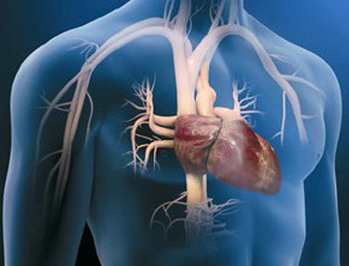
Specifically, it is called Endothelial Progenitor Cells (EPC), those who are destined to become blood vessels, but scientists have managed to differentiate into heart muscle cells (cardiomyocytes).
This ability to change their function, because they are in an initial phase, in which the cells are not mature and therefore they have plasticity, that is, they can be redirected to become cardiac tissue, collected by SINC (Information Service and Scientific News).
"Until now, we knew the beneficial role of EPC, in these pathologies, where the diameter of blood vessels and ischemic heart disease and peripheral arterial disease are reduced. However, little was known about its potential to restore damaged tissue in heart”, said the leader of the project, at the University of Granada, Juan Antonio Marchal.
To clarify its role, scientists analyzed in vitro the ability to become heart cells of EPC samples, isolated from blood of patients with acute myocardial infarction.
They were compared with EPC obtained from umbilical cord blood, a source which is already known that there are stem cells, capable of regenerating cardiac tissue.
"It is the first time that this comparison is developed. Our data indicate that Endothelial Progenitor Cells (EPCs), derived from both sources, patient blood and umbilical cord, have plasticity and similar functions and suggest a potential therapeutic efficacy, in cardiac cell therapy”, as the researcher asserted.
This therapy should consist in inject these cells into the site of injury. "After a heart attack, call effect by these EPC occurs, from the bone marrow, where they are normally found, to the heart, to repair the injury: it is the “homing” effect. However, this mechanism can not move enough cells to completely regenerate damaged tissue”, he explains.
Therefore, the future therapy, proposed by experts, should help patients, with the regeneration process. Moreover, as they are own cells, possible rejections are avoided.
"The injection of cells already done, but we have shown the ability of these infarcted patient's own cells, hence no side-effects are produced", he says.
"However, it is necessary to develop expansion protocols of these cells, from the patient, in the laboratory, so that we can get an adequate number, that had the beneficial effect, once introduced into patients", he says.
To reach their conclusions, published in the journal Cytotherapy, the researchers first isolated endothelial progenitor cells, throughout the existing set of blood cells: white blood cells, red ones, etc.
Once separated, the EPC is allowed to proliferate and add a substance, the 5-azacytidine, which has the capacity to induce them to heart cells, like cells from umbilical cord.
"No significant differences, between the number of colony forming units of endothelial cells, in peripheral blood of patients with myocardial infarction, and umbilical cord samples were observed", concluded the researcher of the UGR.
These results, which will be then transferred to animal testing in live, are the result of the excellence project 'BIOMER CONDROSTEM 3-D: regenerative biomedicine chondral pathology, using autologous stem cells' funded by the Ministry of Economy, Innovation, Science and Employment.
Well, I find it interesting this progress, provided that a good use of stem cells is made.
Until my next blog post, kind regards,
Luis.
Sponsored by Costaluz Lawyers.
Please click below:

 0
Like
Published at 12:22 PM Comments (0)
0
Like
Published at 12:22 PM Comments (0)
La Pepa danced in Spain
Thursday, October 16, 2014
Today, Sara Baras (one dancer of Flamenco, well known in Spain) has spoken on the radio, because, just today, she has presented the show "La Pepa", in the “Compac Theatre” in Madrid, where she is the protagonist: she represents "La Pepa" (the Constitution of Cadiz of 1812).
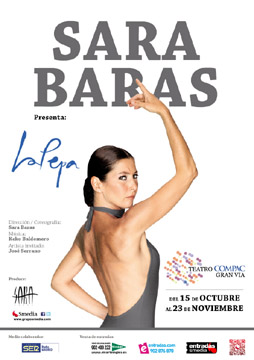
Indeed, Sara has humanized the Constitution of 1812; and, by the way of that, she said, on the radio: "This Constitution, that brings the reflection of Cádiz in 1800, is full of details and moments, that are very special and when you are going to dance them, they have a positive and precious energy” and she also said: "Of course you can dance a Constitution, I do not know how, but it is danced".
The artist, National Dance Award, plays the only allegorical character in the play, La Pepa, and other officers involved in this national historical fact of the War of Independence, as deputies or people from Cadiz are represented by the body of her dance company. The figure of the dancer, José Serrano, stands out in the role of the President of the Courts.
"All off a very good energy and, above all, in the assembly include the value of the character of the people, so horrible as before was that war and they had such strong desire to succeed situation".
"They all detach a very good energy and, above all, in the Assembly, we stand out the value of the character of the people, in front of such a horrible situation as that war was and they had such those strong desire to succeed the situation".
Sara is responsible for the choreography, script, design, scenography and costume. "I have a great team behind, without it there would be nothing and of course without the company, because, so many years together, we function perfectly", said the dancer, who has also complimented the role of the guitarist from Cadiz, Keko Baldomero, who has composed the music assembly, "He has done a sensational job", Sara has said.
Being a story, set in the Tacita de Plata, you can not miss the joys (“Alegrías”) in this show. But fandango, tanguillos, bulerías or seguiriyas are also danced. "In this work, the path of the different styles is going on what we have, for example, when we are in the port, with boats arriving from the Americas, enter the songs back and forth as the Guajira". Baras explained, who moreover the birthplace, has other "very special" connection with this show.
"When we were researching La Pepa, we knew that the first meeting was held in the same building, which, years later, it was my school; there are many details, that make this show for me means a lot", Sara says.
For six weeks, Flamenco enthusiasts, understood or not, will enjoy this show, in Madrid. "Often, the mistake is to think that the public needs to know Flamenco, to enjoy a show, and get it wrong, you have to let go", advises the artist.
“La Pepa” is the end of a road during two years, with 200 functions and over 250,000 spectators, who have already enjoyed, throughout all Spain. "The work has grown in that time, it is now more plump and ended the tour, in Madrid. We are thrilled", Sara has said.
Then focus on his next show, “Voices”, will premiere on December 22, in Paris, and Sara Baras passed us that this is "a concert style setting, not an argument, but dancing by law, pa 'lante, as flamingos say, and it is a tribute to all the voices that have influenced me. Including Paco de Lucía, Camarón, Antonio Gades, Enrique Morente or Moraíto.
If you want to watch the video, with Sara dancing, please click below:
http://www.youtube.com/watch?v=ZB6kWTQWYeE
I love this kind of dancing, when the dancer stamps. And I hope that you like it such as I do.
Till very soon, kind regards,
Luis.
Sponsored by Costaluz Lawyers.
Please click below:

 0
Like
Published at 2:03 AM Comments (0)
0
Like
Published at 2:03 AM Comments (0)
A Spanish letter full of life
Wednesday, October 15, 2014
Today marks 15 days, since Teresa Romero (the Auxiliary hospital, infected with Ebola) joined the “Hospital Carlos III” of Madrid, to combat this virus. Today, it is an important day, because, from now, all the time, that Teresa stays alive, it will be essential to overcome the disease. Today, the doctors, who are attending Teresa, have said that “she is showing a slight improvement". At the same time, the nurses, who are attending Teresa, have commented that today she has been sitting for 2 hours and a half and talked a little bit with them.
She started to create her own antibodies; she begins to have more defenses, to resist the force of the virus.
Today, I would like to write her an email. If I could, I would write her the following:
Dear Teresa:
I do not know you personally, but you were born in Spain, as I did. My daughter is named after you. And my father was from Galicia, as your family. But above all, I sympathize with you, because you have given your life to helping others, risking your own life. However, I want you to continue being strong, because you are going to succeed and many people, who love and need you, are expecting: your mother, your husband, your friends, your colleagues, and even we all, who do not know you, but are waiting for you, out of the hospital, in all Spain .... and ultimately, LIFE is waiting for you.
I wanted to write you, because I thought especially of you, when I saw a video, on the Internet, with a song sung by a spanish singer (Dani Martín); the song is titled "Life is so nice" and, apart from liking its music, I like the message, because it is full of life, and I want to send it to you, because I think that your life is nice and you have to take it care.
Teresa, I am going to pray for you to heal you completely and, as the Sister Patience (the religious from Liberia) who has helped you, with her blood, you can also help other prospective patients, with your renewed blood.
A hug.
Luis.
Here is the video:
http://www.youtube.com/watch?v=IBSbFw5hjOU&index=26&list=RDdPzpSucdJ3w
The Lyrics in Spanish:
Que bonita la VIDA
Que da todo de golpe
Y luego te lo quita
Te hace sentir culpable
A veces cuenta contigo
A veces ni te mira
Que bonita la VIDA.
Que bonita la VIDA
Cuando baila su baile
Que se vuelve maldito
Cuando cambia de planes
Ahora juega contigo
Otras tantas comparte
Que bonita la VIDA.
Y tan bonita es
Que a veces se despista
Y yo me dejo ser
Y tan bonita es...
Es VIDA lo que me das
VIDA tu caminar
VIDA que arrampla
Cobarde que lucha
Que sueña que perderás
VIDA que vuelve a dar
VIDA que sola estas
VIDA repleta de gente
Que nace que vive
Que viene y va.
Que bonita la VIDA
Tantas veces enorme
Te acaricia y te mima
Te hace sentir tan grande
A veces eres su niño
A veces enemiga
Que bonita la VIDA.
Que bonita la VIDA
Que regalo tan grande
Que luego te lo quita
Te hace no ser de nadie
A veces sin sentido
Otras tantas gigante
Que bonita la VIDA.
Y tan bonita es
Que a veces se despista
Y yo me dejo ser
Y tan bonita es...
Es VIDA lo que me das
VIDA tu caminar
VIDA que arrampla
Cobarde que lucha
Que sueña que perderás
VIDA que vuelve a dar
VIDA que sola estas
VIDA repleta de gente
Que nace que vive
Que viene y va.
Y tan bonita es
Que a veces se despista
Y yo me dejo ser
Y tan bonita es...
Es VIDA lo que me das
VIDA tu caminar
VIDA que arrampla
Cobarde que lucha
Que sueña que perderás
VIDA que vuelve a dar
VIDA que sola estas
VIDA repleta de gente
Que nace que vive
Que viene y va.
VIDA, VIDA, VIDA, VIDA...
Que bonita la VIDA
Que te mece con arte
Que te trata de usted
Para luego arroparte
Te hace sentir valiente
Otras tantas don nadie
Que bonita la VIDA.
The lyrics in English:
LIFE is so nice
That gives it all at once
And then takes it away
It makes you feel guilty
Sometimes counting on you
Sometimes it does not look at you
LIFE is so nice.
LIFE is so nice
When she dances its dance
That turns damned
When plans change
Now it plays with you
As many others it shares
LIFE is so nice.
And it is so nice
That sometimes it gets lost
And I let me be
And it is so nice ......
It is LIFE what you give me
LIFE your walk
LIFE that makes out
Fighting coward
Which dreams and that you will lose
LIFE returns to give
LIFE what alone you are
LIFE full of people
Who born, who is living
Who come and go.
LIFE is so nice
So often huge
Caresses and pampers you
It makes you feel so great
Sometimes you are its child
Sometimes enemy
LIFE is so nice.
LIFE is so nice
What a big gift
That then takes it away
It makes you do not belong to anyone
Sometimes nonsense
So many giant
LIFE is so nice.
And it is so nice
That sometimes gets lost
And I let me be
And it is so nice ...
It is LIFE what you give me
LIFE your walk
LIFE that makes out
Fighting coward
Which dreams and that you will lose
LIFE returns to give
LIFE what alone you are
LIFE full of people
Who born, who are living
Who come and go.
And it is so nice
That sometimes it gets lost
And I let me be
And it is so nice ...
It is LIFE what you give me
LIFE your walk
LIFE that makes out
Fighting coward
Which dreams and that you will lose
LIFE returns to give
LIFE what alone you are
LIFE full of people
Who born, who are living
Who come and go.
Life, life, life, life ...
What a nice LIFE
That rocks you with art
That address you as usted
Then it tucks you
It makes you feel brave
So many a nobody
LIFE is so nice.
Well, I hope that you get along with me, when I think that LIFE is so nice, in spite of the different and hard situations, that we have to live.
Until my next post, kind regards,
Luis.
Sponsored by Costaluz Lawyers.
Please click below:

 0
Like
Published at 12:02 AM Comments (0)
0
Like
Published at 12:02 AM Comments (0)
Pure Flamenco looking at The Alhambra, South Eastern Spain
Friday, October 10, 2014
Enrique Morente was born looking at the Alhambra. That told his friends and in an interview, before his death, that fateful December 2010. He was born in a house on the Albayzin, opposite the Red Hill, and, from his earliest days to the end of his life, he never departed from that landscape of his immortal Granada.
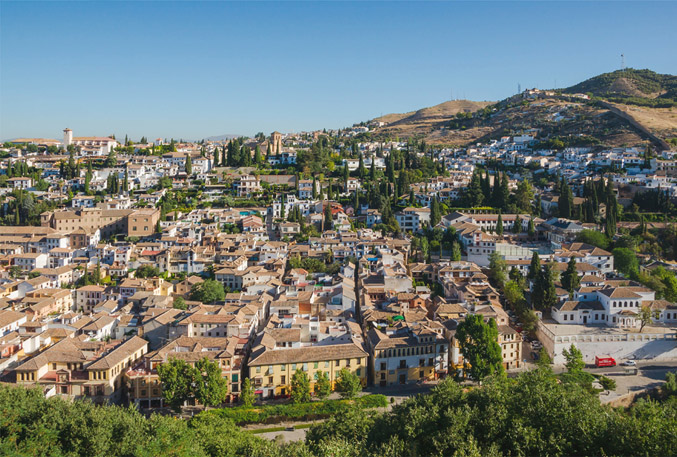 The Albayzin, Granada, South eastern Spain The Albayzin, Granada, South eastern Spain
Here I bring you a video with Enrique Morente singing “Bulerías”—a kind of Flamenco singing from Cádiz--, that I love, in the Festival of Jazz in Vitoria-Gasteiz, in 2006. If you want to enjoy the video, please click on the link below:
http://www.youtube.com/watch?v=Ky8Dq_v8Yuo
The last September, they have paid homage in the Alhambra. “Morente Universe” is a project that combines music, art, literature and, of course, travel. The tribute consists of several parts. The first is entitled “Graná sings” (Graná = Granada), plays and dances to Morente and it has been the last Friday, September 5, at the Theatre of the Generalife, the 6th in the Alhambra Theatre and the 20th of that month, in the Hall “The Train”.
Between another artists, was Iván Vargas ( “Bailaor” = Flamenco dancer). Let me show you a video, with Iván dancing, because I love this type of dance. If you want to watch him dancing, during the homage to Enrique Morente, please click on the link below:
http://www.youtube.com/watch?v=DvyScE6jK3Y
The 26th took place one night of poetry and literature around the artist, at “La Tertulia”, and, from October, the Universe Morente exhibition will take place in the Palace of Charles V.
There is a “Morente´s Alhambra”, which would be in your interest to walk listening to the master, one of the most illustrious ideologists, in the history of Flamenco. Enrique owned a house, in the Plaza de San Nicolás, in the heart of Albayzin, one of the most photographed spots in Granada.
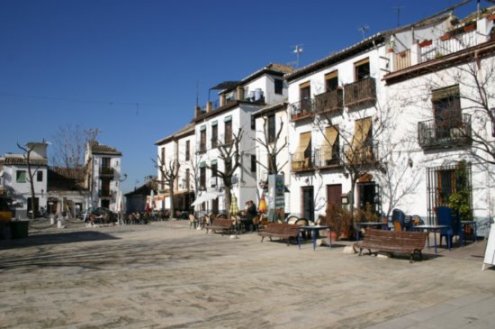
The Square "Saint Nicolas"
When his life there became uncomfortable, due to the number of fans who daily visited him, he moved to another neighbourhood, nearby the church of San Luis, between Upper Albayzin and the neighbourhood of Sacromonte Caves, near where starts the trail, which leads uphill to the hermitage of San Miguel Alto, one of the most beautiful parts of the city.
His house was facing the Alhambra. In his recording studio, there was a huge window, where he kept his guitars, his favorite records and he warmed up his voice. It was a special place, because the singer stood facing the Nasrid monument, while rehearsing his songs.
The “Morente´s Alhambra” has a number of milestones, that you must not miss. The master loved to explore the Alcazaba, especially the coastal path leading to the Torre de la Vela, up the stairs of the fort and lean from the battlements to his city, in order to watch, to the north, the roads that climb up to Jaén; lowering the look at the Vega and ending in the south, where the sigh of the Moor is and behind the peaks of Sierra Nevada, hiding the nearby Mediterranean.
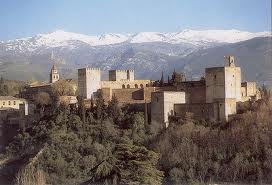
The Alhambra and Sierra Nevada at the background
The Nasrid Palaces --Myrtles and Lions--, were mythical places for the singer. There he sang his tunes for the filming of the “Morente dreams the Alhambra”, directed by José Sánchez-Montes and starring, among others, by the great American guitarist, Pat Metheny.
In the Royal Baths of Comares, the master sang, with his daughter, Estrella, poems of St. John of the Cross and, in the gardens of The Partridge, under its arches and front of his mirror-pond, half sang a song with the Algerian Cheb Khaled.
The Morente´s route through the Alhambra extends to the “Puerta del Vino” (Door of wine), the house of guitarist Angel Barrios and delicious ride of El Secano (The Dry), leading to la “Torre del agua” (the Water Tower) and acrossing el “Puente de los Chinos” (the Bridge of Chinese), at the entrance to the domains of the Generalife, the architect´s garden, the summer residence of the Nasrid sultans.
There is situated the theater, where the Morente´s music has been interpreted, dozens of times and the gardens projected by Torres Balbás and Prieto Moreno, that anticipate the Moorish palace, from whose arbours it is enjoyed, in the words of the most experienced travelers, one of the most memorable sunsets, on the face of the earth.
Well, I hope that you have enjoyed with this post.
Until my next post, kind regards,
Luis.
Sponsored by Costaluz Lawyers.
Please click below:

 0
Like
Published at 12:49 AM Comments (0)
0
Like
Published at 12:49 AM Comments (0)
A Prize for Big Six in Andalusia, Southern Spain
Sunday, October 5, 2014
The Awards “El Caminante” (The walker), organized by the newspaper El Mundo from Andalusia, were given yesterday, October 3, in the "Arab baths" Centre of Jaén, in recognition of the different faces, that Andalusia shows. This year, the winners are: Cordoba in May, the Alhambra in Granada, Malaga Axarquia, the Parador of Cadiz, the "Juanito" Restaurant of Baeza, and the "Oleotour" project in Jaén.
The “Cordoba in May” Award is recognition for one of the most important celebrations in Spain, a party that starts on day 1 and ends on 31st of that month, and where the city becomes a stage, in a continuous ceremony around its monuments, streets, squares and its beautiful houses.
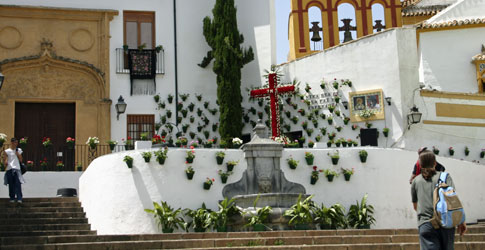
Cuesta del Bailio, Córdoba, South of Spain
There is no month, that characterizes such a ciity. The whitewashed of old town streets, courtyards decorated with pots of many colors, spirited squares, the pleasant and hospitable taverns, monuments of a single capital become the stage, where no one is a stranger. The festival starts with the procession of Santo Domingo, continues with the Battle of Flowers, the pilgrimage of the Virgin of Linares, the Crosses of May, the Festival of the Patios and ends, at the end of the month, with the Fair of Our Lady of health. Córdoba in May will receive the Award to the Touristic trayectory.
The second awarded site of Andalusia is “The Alhambra of Granada”:
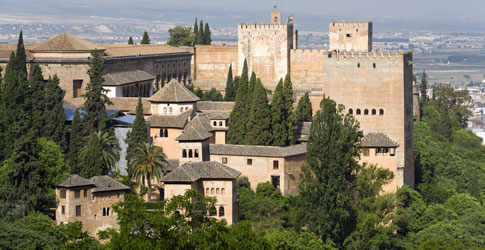
The Alhambra, Granada, South eastern Spain
There is no monument, in Spain, with so much life. To the museum, that contains the Palace of Carlos V, it adds the tenacity of the Alhambra and Generalife Board, directed by María del Mar Villafranca, to turn this legendary venue on a meeting space of culture and art. Temporary exhibitions, organized by the Alhambra, are considered among the best in Europe.
To that dedication, are added programs and projects like “La Dobla de Oro” (Golden Fold), the last happy idea of those responsible, for the institution, that seeks to unite the set with white Albayzin district, through the houses and palaces of Moorish epoch. To The Golden Fold are added other initiatives, such as alternative visit to the Alcazaba, the Nasrid Palaces and the Generalife. Programs, such as guided visits by specialists, for example, arouse the interest of an enlightened traveler, lover of sophistication, legend and teaching this set awake. The Alhambra in Granada, the most visited monument in Spain, has been recognized with the Award for “Brand of the Year”.
The “Axarquía of Málaga”:
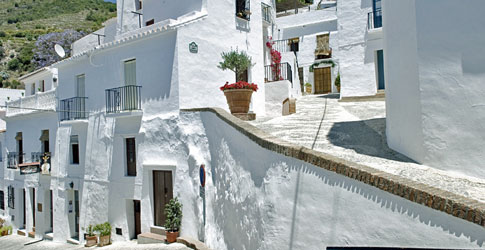
A street in Frigiliana, La Axarquia, Malaga, South eastern Spain
It is one of the most beautiful regions of Andalucía, a mythical place, portrayed since times of romantic travelers and exalted by the historical chronicles of the Moors and its early Christian inhabitants. The Axarquia of Malaga, the language of rolling land, between the sea and the mountains, has been recognized with the “Tourism Product of the Year” Award, by the initiatives launched, in recent years, which have attracted a growing number of travelers interested in landscape, nature, traditional architecture and cuisine.
The Axarquia is owner of the Wine Route, that link together, from Nerja to Canillas de Aceituno, the winemaking landscapes of Frigiliana and Competa and whose wines, care with caress and patience, are listed among the most coveted by the most demanding mouths. To the Wine Route, other tourist itineraries, as the Mudejar Route, are added, which invites us to recognize, in the white villages, that speck the slopes of the Natural Park of Alhama, Tejeda and Almijara, artistic impression of the last Moorish.
The Parador of Cadiz:
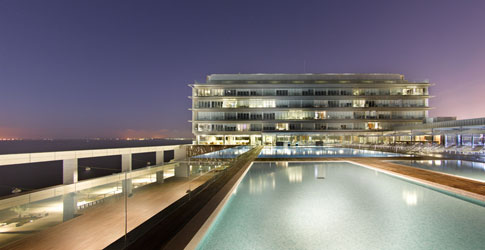
The Parador of Cadiz, South western Spain
The old Atlantic Hotel, later converted into a Parador and remade, as a whole, has been a boost for tourism of “La Tacita de Plata” (“The little Silver Cup”), the oldest city of the West. The Parador of Cadiz is a modern gem, with stunning views, to the bay, from any place where the guest takes a peek: its terraces, its airy rooms, its exclusive swimming pool, its relaxing SPA………The restaurant and the place for eating tapas allow to enjoy delicious delicacies, and the Assembly Rooms are the perfect place and a successful bet.
Just a few steps from the hotel, is the beach of La Caleta, which invites you to walk along the promenade, witness to the years, in which the port was important link with the New World, and where to evoke the image of the beautiful boardwalk of The Havana. The Cadiz Cathedral is another example of colonial splendor of this city. The air, that we breathe in Cadiz, seduces its charming neighbourhoods, like Pópulo, the oldest, and the Santa Maria neighbourhood, with beautiful baroque houses, are just two examples. The Parador of Cadiz has been recognized with the award for “Hotel of the Year”.
The Restaurant “Juanito”, in Baeza:
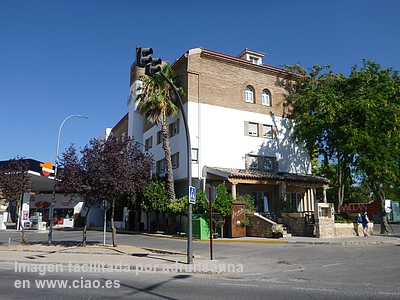
The Hotel-Restaurant "Juanito", Baeza, Jaen, South of Spain
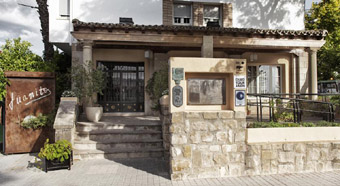
The restaurant "Juanito"
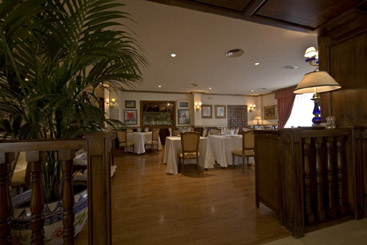
A dining room in the restaurant
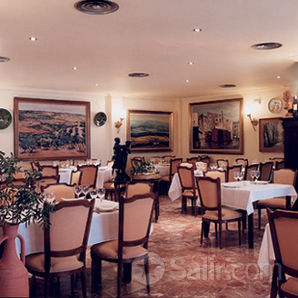
Another dining room
“Juanito of Baeza” has been recognized with the award for ”Restaurant of the Year”. If there is a restaurant, that summarizes better than any other popular Spanish cuisine, that is “Juanito”. The Salcedo family was the first to pontificate extra virgin olive oil, while the main ingredient of the Mediterranean diet, just did not enjoy the fame it enjoys today.
In Spain, thirty years ago, which restaurants emphasized, in their menus, that all dishes were made with the finest extra virgin olive oil?. “Juanito” did it and, for leaving proof of it, after an insurmountable appetizer of “ropavieja” (old clothes) --cocido mareado (dazed stew)-- and croquettes, stood in front of the paid diner, a partridge pate dish bathed in abundant olive oil flavored.
The “Oleotour in Jaen”:
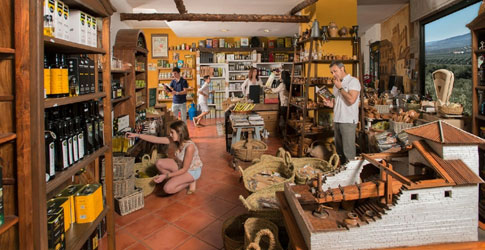
The Oil shop of Oleotour, in Jaen
Oleotour is one of the most unique tourist proposals, in order to know the world around the preparation and taste of extra virgin olive oil from Jaén, an unique opportunity to learn how a good oil is produced, to taste it, learn to taste and differentiate it, to go into ecstasies yourself with a unique landscape, in the world, and access to offers around health and beauty, with the oil as the basis of the best beauty treatments.
Under the motto "Come to the olive and make your own oil“, the Jaén Provincial Council has created a new touristic proposal. To participate in a wine tasting, visit an olive grove to collect, transfer it to a mill and to grind it, in order that you get your own oil, are some of the activities of this initiative. The traveler is invited to know a family process for the people from Jaen, but unknown and mysterious process for most, an unforgettable experience and an adventure for the senses in the land of olive cultivation.
Well, I think that it news Is very interesting and I hope that you think the same.
Until my next blog post, kind regards,
Luis.
Sponsored by Costaluz Lawyers.
Please click below:

 0
Like
Published at 12:49 AM Comments (0)
0
Like
Published at 12:49 AM Comments (0)
A lesson in life and overcoming in Spain
Thursday, October 2, 2014
This morning, by chance, I listened an interview, on the radio, to a boy, who has written a book, with his experiences since he is in a wheelchair.
His name is Daniel Stix and he is 17 years old. He is a very positive boy; but, at the same time, very simple, and that has helped him overcome some very difficult situations, simply to overcome them, but enjoying and never feeling better or superior to others himself.
When Daniel was born, doctors told her parents that Daniel had cancer and he only had a 20 percent chance of living, then his mother cried a lot; but, one day, she thought she had to do anything to improve the life of her child.
Daniel love sports –above all those where adrenaline is greater--. Then he started to play Basketball. He plays in the “Fundosa ONCE” team. Daniel says that sport has helped him to overcome many obstacles and that the "desire to excel is essential to overcome the obstacles that life puts you ahead”.

We can see Daniel, with his kit of basketball, on the cover of his book, entitled "Rolling Like It Hot" --which by the way, reminds me of the title of a famous film, "With skirt It Hot", starring Marilyn Monroe--.
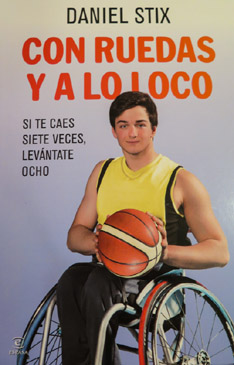
But Daniel also likes other sports such as Skiing. Although, he once broke a leg of him. He says his sense of humor helped him to better bear the consequences of that accident.

Although Daniel was cured of Cancer, however he could never walk.
One of the sports that Daniel prefers is the Kite-Surf. And the funny thing is that he and his friends built the special board. By the way of that, his mother also was on the radio and she says that Daniel has got several challenges thanks to several Foundations, because his mother said she could never pay all those activities.
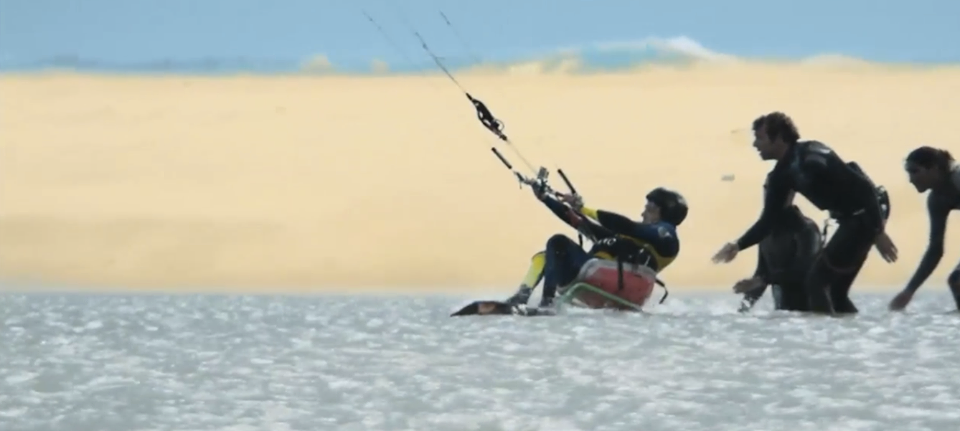
I loved this interview, for two main reasons: because it is a lesson of life, among Daniel and his mother; I mean, it is very important the freedom that Daniel's mother has given him, to choose various adventure sports --in spite of Daniel is a minor (he is only 17 years old)--. She helps him and watches; but she respects his pleasure. Moreover, with this attitude, she is not overprotecting Daniel --and this also helps him. A long time ago, I heard doctors and psychologists said that "it is not good overprotect a disabled"--.
The other reason is because it is a lesson of overcoming. Daniel says that sport has been an instrument to overcome many obstacles in his life.
Daniel has written this book to tell their experiences and in case he can help someone who lacks the same courage, that he put in all that seeks to achieve.In fact, on the cover of the book, you can read a sentence by Daniel, which says: “Si te caes siete veces, levantate ocho” (“If you fall seven times, get up eight”).
I hope that you can buy the book and enjoy it.
Until my next post, kind regards,
Luis.
Sponsored by Costaluz Lawyers.
Please click below:

 1
Like
Published at 1:32 AM Comments (0)
1
Like
Published at 1:32 AM Comments (0)
Spam post or Abuse? Please let us know
|
|